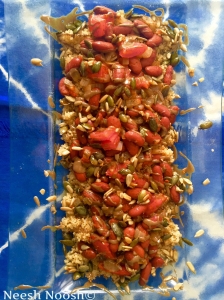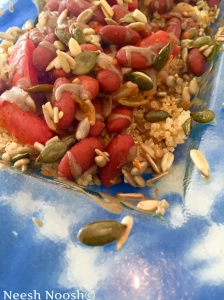Iyar-the second month in the Jewish calendar–is a connector month, between Nisan (Pesach–the exodus and establishment of the nation of Israelites) and Sivan (Shavuot–the receiving of the Torah). Rabbi Adin Steinsaltz writes that Pesach “asks us to stop walking the old, familiar paths, and to create change within ourselves and in our relationship with others and with the world.”
Such a process of introspection and healing doesn’t end at Pesach but rather begins. Iyar is a time to sow the seeds of our personal and communal transformations that were planted at Pesach through our liberation from slavery and to prepare for receiving the Torah in Sivan. It “is the month of introspection for the sake of self improvement.” Liberation does not mean one’s journey is complete. And, such a journey is not done alone. Iyar is known as a healing month. The acronym of Iyar is represented by the phrase, “I am G-d your healer” (Exodus 15:26). (The manna the Israelites received from G-d during their time in the wilderness first appeared in Iyar, solidifying their reliance on G-d to survive.)
According to the Talmud, the physical symbol of Iyar is the right kidney. Sarah Schneider explains, “In the kabbalistic system of correspondences, kidneys are the subconscious/instinctive root of emotion, as opposed to the heart area.” She continues that in Kabbalah, the kidneys include the entire lower torso, including the reproductive organs. “According to Kabbalah, the chain of generations, the link that joins parent to child is first and foremost a primal bond at the level of kidneys. . . . Each family tree is both a bloodline and a lineage of neuroses, which parents transmit to children metaphorically through their kidneys”
Since our liberation from Egypt, we each carry generational burdens from our ancestors. Iyar is an opportunity to do this transformational healing. It’s not about disconnecting from our families but rather being liberated from our relatives burdens and traumas that are not our responsibility to carry or pass onto another generation. Sarah Schneider explains, “That is why the greatest gift we can give to our parents is the progress we make in bringing rectification and consciousness to our lives. That’s what it means to carry on their work.”
The potential impacts of this physical and spiritual work is both personal and communal. The month of Iyar is also called Ziv, which means radiance. Indeed, Iyar’s “role is to absorb the great light and internalize it, on the personal spiritual level and on the cosmic level of repairing the world.”
The recipe that I prepared is based on the themes of kidneys and planting of seeds. There are many types of seeds in the recipe (quinoa, sunflower, pepitas and sesame {which are in the tahini and zaatar]). The mix of honey and olive oil in the dressing is a reminder of how the manna tasted to the Israelites. In addition, the seeds are representative of the multitude of the counting of the omer that begins after Pesach and concludes at Shavuot.
Iyar: Beans and Seeds
Ingredients
1/3 cup quinoa, uncooked
1.5 cups cooked kidney beans
1/2 yellow onion chopped
2 cloves garlic chopped
1 tomato chopped
1 tbsp sunflower seeds, hulled
1 tbsp pepitas
2 tbsp tahini
dab of schug or other hot sauce
dab of honey
generous pinch of zaatar (about 1 tbsp)
salt and pepper to taste
olive oil
Preparation
1. Cook quinoa.
2. On low-medium heat, add a bit of olive oil to a pan and warm. Add pepitas and sunflower seeds. Toast until lightly browned. Remove from heat and place in a bowl.
3. Add about 1/2 tbsp olive oil to the same pan. Add onion and garlic. Cook until soft and translucent, about 5 minutes. Add beans and chopped tomato and continue to cook until thoroughly mixed, approximately 5 minutes. Add a small amount of schug (or other hot sauce) and honey. Mix well. Remove from heat and add salt and pepper to taste. Add a generous heaping of zaatar and mix well.
4. On a platter, put quinoa on bottom layer. Spread bean mixture on top. Sprinkle seeds over it. Then, drizzle with tahini.
B’tayavon!




I really loved this post, Sarah. I’m not Jewish, but the theme of transformation and being liberated from generational baggage really resonated with me. Thanks.
LikeLiked by 1 person
Thank you so much! and the teachings are universal-for everyone 🙂
LikeLike
Pingback: 206: Roasted Cauliflower | Neesh Noosh